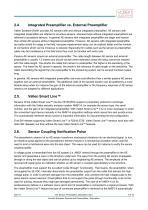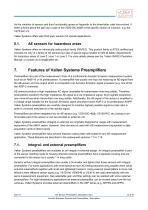 Website:
VALLEN SYSTÈME
Website:
VALLEN SYSTÈME
Catalog excerpts

Acoustic Emission Sensors and Preamplifiers Description Released 2021-11
Open the catalog to page 1
Contact Address Vallen Systeme GmbH Bürgermeister-Seidl-Str. 8 82515 Wolfratshausen Germany email: info@vallen.de web: http://www.vallen.de Specifications are subject to change as product developments are made. Comments and recommendations are appreciated and may be mailed to: sales@vallen.de Copyright © 2021, Vallen Systeme GmbH All rights reserved. Electronic versions of this document may be read online, downloaded for personal use, or referenced in another document as a URL to a Vallen website. No part of this specification may be published commercially in print or electronic form,...
Open the catalog to page 2
file: Sensor_Preamplifier_Description.docx Acoustic Emission Sensors and Preamplifiers - Description
Open the catalog to page 3
Introduction to Acoustic Emission (AE) Sensors The sensor constitutes the first part in an AE measurement chain and as of this is of particular importance. A subsequent measurement system can only process signals which the AE sensor picked up. Anything an AE sensor does not pick up is lost for analysis. An AE sensor converts the surface movement caused by an elastic wave into an electrical signal which can be processed by the measurement equipment. The piezoelectric element of the AE sensor should pick up faintest surface movements (i.e. have high sensitivity) and convert this movement most...
Open the catalog to page 4
Frequency Range Vallen Systeme follows a coarse and arbitrary classification into 3 frequency regimes, which is justified by the fact that most applications can be classified into one of these frequency regimes: low (20 kHz - 100 kHz), standard (100 kHz - 400 kHz) and high (>400 kHz). Attenuation per unit distance increases with frequency. For most applications, frequencies above 400 kHz are meaningless and are cut-off in order to minimize electronic noise. Some standard preamplifiers and signal processors are able to process frequencies up to 2.2 MHz (e.g. AMSY-6). The classification in...
Open the catalog to page 5
Integrity testing of composite materials Integrity testing of concrete structures Drying process monitoring of plants/wood AE testing of small specimen Determining the Correct Frequency Range of AE Sensors for an Integrity Testing Application The elastic wave is usually heavily affected by the propagation mechanisms before it reaches the AE sensor. The frequency content of the wave is particularly affected by the source mechanism as well as the material through which the wave propagates. The material in which an elastic wave propagates has a very inhomogeneous effect on the frequency...
Open the catalog to page 6
Integrated Preamplifier vs. External Preamplifier Vallen Systeme GmbH provides AE sensors with and without integrated preamplifier. AE sensors with integrated preamplifier are referred to as active sensors, whereas those without integrated preamplifiers are referred to as passive sensors. In general AE sensors with integrated preamplifier are larger and heavier than similar AE sensors without integrated preamplifier. However, AE sensors with integrated preamplifier are better suited for usage in the field, because measurement setup can be realized faster and the number of connectors which...
Open the catalog to page 7
All Vallen Systeme external preamplifiers (i.e. AEP series, see “Acoustic Emission Preamplifier” document) support the pulse through capability. Most Vallen Systeme AE sensors with integrated preamplifiers also support the pulse through functionality. This is indicated by a “C” (calibration bypass) at the end of the AE sensor name, e.g. VS150-RIC. All passive AE sensors (without integrated preamplifier) can be used for pulsing anyway. Vallen Systeme supports another pulsing mode for its intrinsically safe AE sensors. Hereby only a low energy control signal is transmitted from the signal...
Open the catalog to page 8
Adhesive Mount (Bonding) An AE sensor may also be bonded directly to the object’s surface. Care should be taken choosing the right adhesive which should not attack the surface it is applied to. The adhesive will also act as a couplant. Most sensors have a ceramic wear plate glued in front of the sensitive area to protect the piezoelectric element. Irreparable damage could be introduced to the ceramic wear plate if this bond breaks before the mounting adhesive during the attempt to remove the sensor from the test object. Similarly the test object (e.g. composite materials) could get damaged...
Open the catalog to page 9
We recommend verifying every AE sensor in certain intervals depending on its usage and application. This verification is especially recommended if an AE sensor has been dropped, exposed to high temperatures or in any case when the AE sensor response give reasons to doubt the integrity of it. Vallen Systeme is able to verify most AE sensors available on the market. The verification tool called Vallen Sensor Tester (VST) is also available for purchase. The VST generates frequency response graphs which can be used to identify response changes over time. See document “Accessories for Acoustic...
Open the catalog to page 10
Olympus V103 (ultrasonic wideband sensor) is used as emitter. AE sensor under test is coupled face-to-face to emitter using a suited couplant (e.g. light machine oil). For the VS30-V and VS75-V an Olympus V101 is used instead of the V103. The other settings can be seen from the legends in the frequency curves. Sensor Categories AE sensors can be classified into sensors with integrated preamplifier and sensors without integrated preamplifier. According to the classification into 3 frequency regimes (see section 2.3) low frequency-, standard frequency- and high frequency sensors are...
Open the catalog to page 11
As the variation of sensors and their functionality grows an Appendix to the three-letter code has evolved. It either informs about the gain as in case of the VS30-SIC-46dB or the specific version of a sensor, e.g. the VS75-SIC-V2. Vallen Systeme offers also third party sensors for special applications. AE sensors for hazardous areas Vallen Systeme offers an intrinsically safe product family (ISAFE3). This product family is ATEX certified and consists not only of a family of AE sensors but also of special signal isolator to fulfil all safety requirements for hazardous areas of zone 0, zone...
Open the catalog to page 12All VALLEN SYSTÈME catalogs and technical brochures
-
VS150-RSC-V2
2 Pages
-
VS150-RSC
2 Pages
-
VS150-RI
2 Pages
-
VS150-R
2 Pages
-
VS150-MS
2 Pages
-
VS150-M
2 Pages
-
VS150-L
2 Pages
-
VS150-K3
2 Pages
-
VS150-K2
2 Pages
-
VS150-K
2 Pages
-
VS150-F
2 Pages
-
VS75-V
2 Pages
-
VS75-SIC-34dB
2 Pages
-
VS75-SIC-V2
2 Pages
-
VS75-SIC-40dB
2 Pages
-
VS75-SIC-34dB
2 Pages
-
VS75-SI-40dB
2 Pages
-
VS45-H
2 Pages
-
VS30-V
2 Pages
-
VS30-SIC-V2-46dB
2 Pages
-
AE–Preamplifier Data Sheet
2 Pages

























